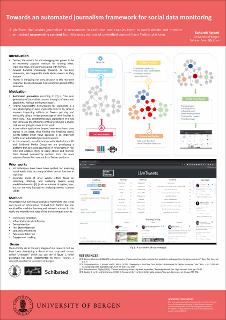| dc.description.abstract | News and information dissemination have long been a vital human practice. Concurrent with the traditional media channels such as radio and television, online social networks (OSNs), are regarded as the new generation of media that seem to have the ability to compete with traditional media. Millions of individuals around the world can communicate breaking news on social media platforms during the hours after midnight. The spread of misinformation and disinformation aside, the process of publishing news on OSNs, to a very good extent, happens more openly and unbiasedly. Automated journalism or according to [1] “the auto generation of journalistic stories through software and algorithms, without any human input”, can be used in newsrooms to supplement or replace traditional journalism in a variety of ways, such as providing real-time reporting of events or generating stories from data that would be otherwise difficult to mine. Due to their real-time and open nature, OSNs, particularly Twitter, are among the greatest candidate data sources to be explored in this context. MediaFutures, Centre for Research-Based Innovation (SFI), is a research centre in Bergen, Norway, which is a consortium of the most important media players in Norway and beyond. The centre is hosted and lead by the University of Bergen’s Department of Information Science and Media Studies. In this research, in collaboration with MediaFuture SFI, we are developing a platform that can assist journalists in newsrooms in real time and enables them to easily obtain and monitor their desired newsworthy content from the mass volume of unverified content from Twitter platform. AI techniques have been applied for analysing social media data but many of them do not function in real time. In MediaFuture SFI we are involved in developing innovative tools which could be used by the journalists in the newsroom daily, secondly, most of prior works, either focus on collecting, filtering, and analysing tweets using predefined metrics [2] (such as number of replies, likes, etc.) or are only focused on analysing tweets’ content [3][4]. Considering the lack of a comprehensive framework suited to the needs of journalists, we present our own visual analytical framework that is not only based on information retrieval from Twitter but also enriched by machine learning and network science. In this work, we intend to use state of the art techniques such as community detection, influential node identification and monitoring, fake news, deepfake and cheapfake detection, etc. | en_US |
